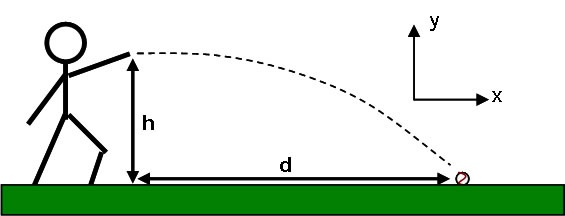Part A
Suppose you are throwing a baseball. You release the ball with a perfectly horizontal velocity of 5.0 m/s at a height of 1.5 m above the ground. How far will the ball travel horizontally from the instant it leaves your hand until the instant it first contacts the ground?
Solution
System:
The ball will be treated as a point particle.
Interactions:
External influence from the earth (gravity).
Models:
The ball is in projectile motion, so we model the x-component of the ball's motion as One-Dimensional Motion with Constant Velocity and the y-component as One-Dimensional Motion with Constant Acceleration.
Approach:
Diagrammatic Representation
The first thing to do is to sketch the situation, which allows us to summarize the givens and unknowns and also to set up a coordinate system.
In the problem statement, we are told that h = 1.5 m (as drawn in the picture) and we are asked for d. By drawing coordinate axes into our picture we have denoted the positive x and y directions. We have not yet chosen the origin, however (the axes can be placed wherever you wish on the picture to avoid clutter). We will take that step now. We choose our origin such that the position x = 0 m is the location at which the ball leaves the hand. The location y = 0 m is the level of the ground.
Mathematical Representation
With the choice of coordinates made, we can summarize the givens (along with our traditional choice that ti = 0 s):

It is important to note that the phrase perfectly horizontal velocity of 5.0 m/s implies that the full velocity (5.0 m/s) is directed along the x-axis, with zero y-component for the initial velocity. This phrasing is extremely common in physics. You will also encounter the perpendicular case of a "perfectly vertical velocity". It is also worth remarking that although 5.0 m/s is the velocity at the instant of release (clearly the ball's initial velocity for the freefall trajectory of interest) we have written vx = 5.0 m/s rather than vx,i = 5.0 m/s. This is not a typo, because the x direction is subject to the 1-D Motion with Constant Velocity model (recall ax = 0). Because the x velocity is constant, it does not require labels for initial or final states.
We are asked for d, which appears in the x direction givens. For this reason, we should first consider the Laws of Change available for the x direction. Because of the simplicity of the 1-D Motion with Constant Velocity model, there is only one available Law of Change:

We cannot solve this equation, however, because we do not know x or t. We therefore proceed to use an extremely useful technique. We will use the y direction to solve for the time t. Once we have this, we can use it in the x direction equation to obtain the information requested by the problem.
In projectile motion, if the direction which explicitly contains the desired unknown quantity does not yield solvable equations using the problem givens, it is extremely likely that you should solve the other direction for time.
In the y direction we have four Laws of Change to consider. The most direct way to proceed is to use:

which at first looks messy, but after substituting zeros becomes:

which is solved to give:

and we must choose the plus sign since we have already set up the problem with the ball released at t = 0 s.
This time can be substituted directly into the x direction Law of Change to give:

To be clear, we show the substitution:

Note that the negative sign under the square root was canceled by the negative y acceleration. When you see a negative sign appear under a square root, you should always check that it is canceled by the algebraic signs of the given quantities. If it does not cancel, it is an indication of a math error! Such warnings are extremely valuable when checking work.
Part B
Suppose you are throwing a baseball. You release the ball with a perfectly horizontal velocity at a height of 1.5 m above the ground. The ball travels 5.0 m horizontally from the instant it leaves your hand until the instant it first contacts the ground. How fast was the ball moving when you released it?
Solution
System, Interactions and Models: As in Part A.
Approach:
Part C
Suppose a certain major-league pitcher releases a fastball with a perfectly horizontal velocity of 95 mph. The ball is released at a height of 6.0 feet above the ground and travels 60.0 feet before being caught by the catcher. At what height above the ground should the cathcer place his glove?
System, Interactions and Models: As in Parts A and B.
Approach:
